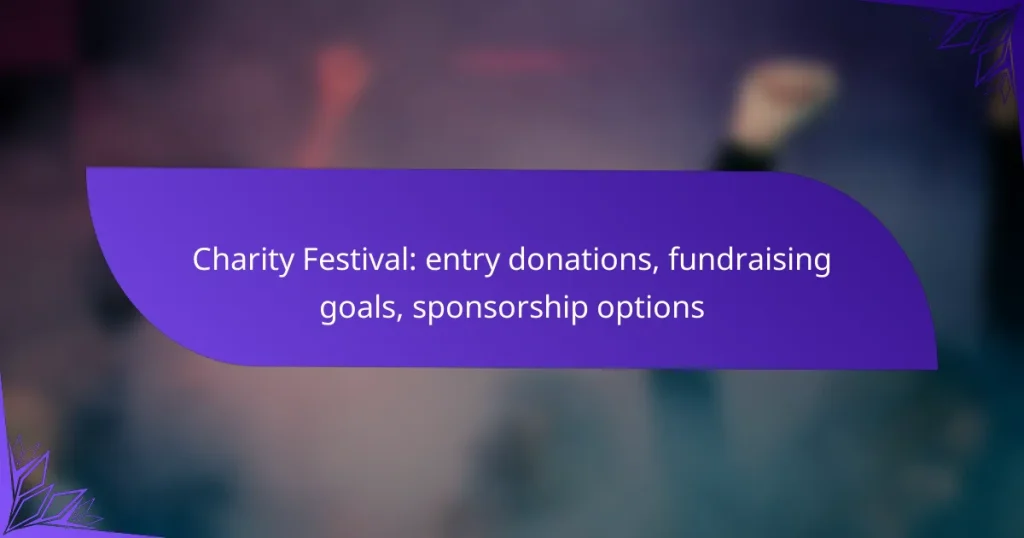Charity festivals rely on entry donations to provide vital funding for event costs and support important charitable initiatives. By setting clear and achievable fundraising goals, organizers can effectively motivate participants and enhance the festival’s impact. Additionally, various sponsorship options are available, allowing businesses to engage at different levels and contribute to the festival’s success while aligning with their own objectives.
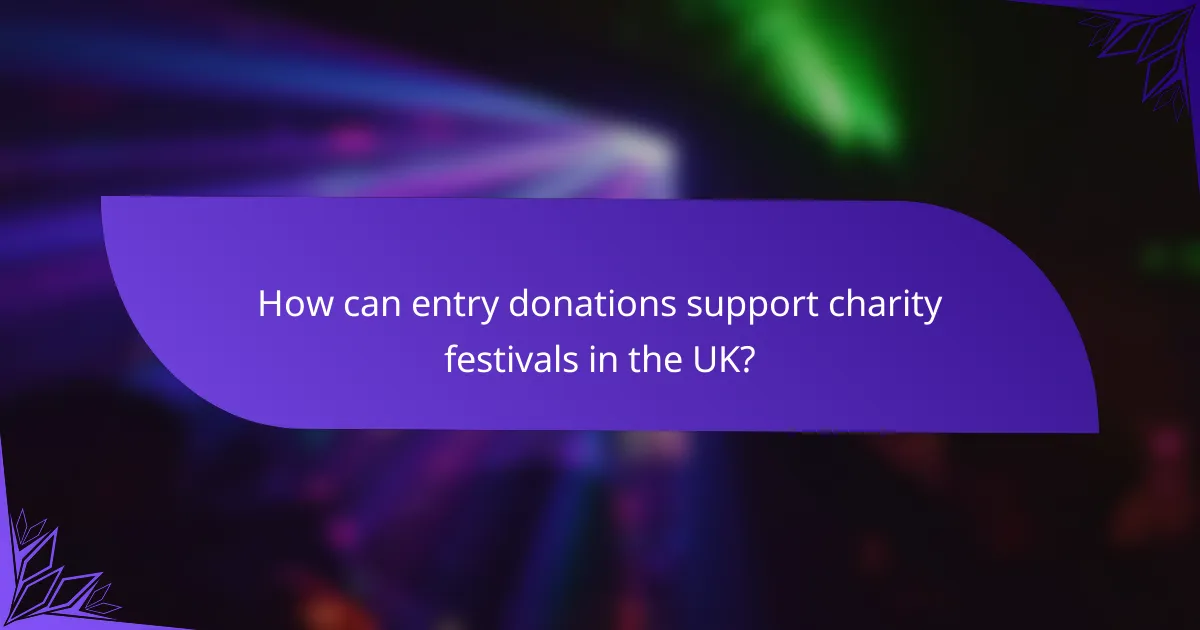
How can entry donations support charity festivals in the UK?
Entry donations play a crucial role in supporting charity festivals in the UK by providing essential funding for event costs and charitable initiatives. These contributions can significantly enhance the overall impact of the festival, enabling organizers to reach their fundraising goals and support various causes.
Direct financial contributions
Direct financial contributions from entry donations are vital for covering the operational costs of charity festivals. These funds can be allocated to venue rental, permits, insurance, and staffing, ensuring the event runs smoothly. For instance, a festival might charge an entry fee of £10 to £20, with all proceeds going directly to the chosen charity.
When setting entry donation amounts, consider the target audience and the overall experience offered at the festival. Offering tiered pricing or family discounts can encourage higher attendance and increase total donations.
In-kind donations for event costs
In-kind donations, such as goods or services provided free of charge, can significantly reduce the expenses associated with charity festivals. Local businesses may donate items like food, beverages, or equipment, which can enhance the festival experience while minimizing costs. For example, a local bakery might supply cakes for a bake sale, directly benefiting the event’s fundraising efforts.
To maximize in-kind contributions, create partnerships with local businesses and clearly communicate the benefits of supporting the festival. Acknowledging their contributions publicly can also encourage more businesses to participate in future events.
Online donation platforms like JustGiving
Online donation platforms such as JustGiving facilitate easy contributions from attendees and supporters who may not be able to attend the festival in person. These platforms allow users to donate directly to the charity associated with the festival, often with minimal fees deducted from the total amount. This can significantly boost overall fundraising efforts.
Promote the use of online donation platforms through social media and festival marketing materials. Providing a clear link and instructions can encourage more people to contribute, even if they are unable to attend the event. Additionally, consider setting up a fundraising page that tracks progress towards specific goals to motivate potential donors.
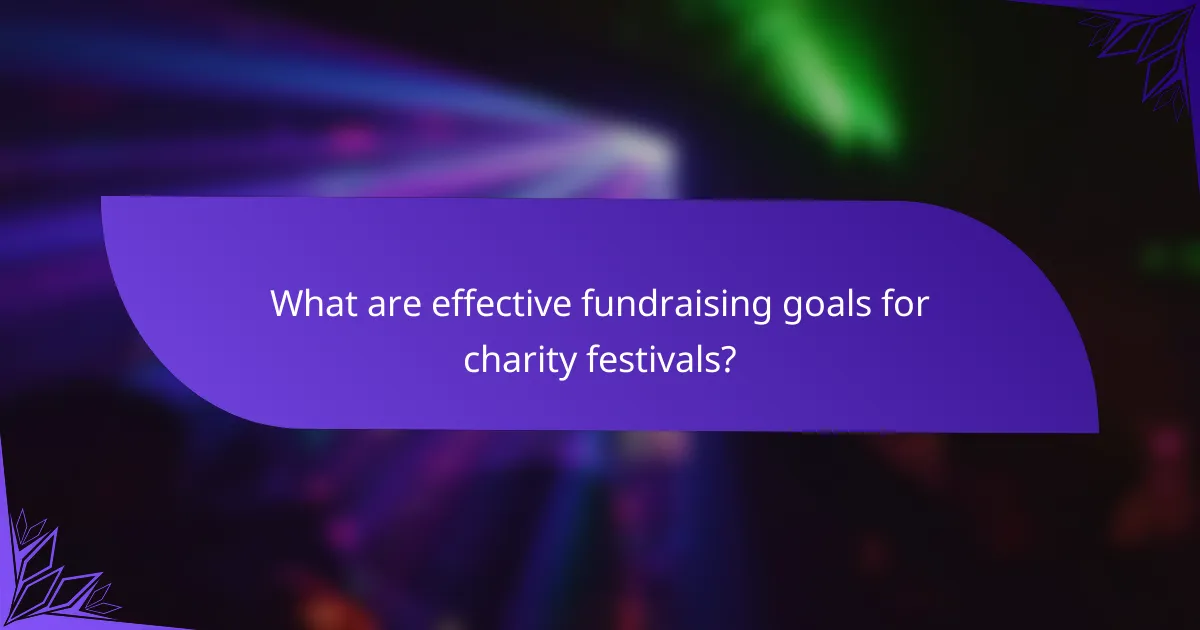
What are effective fundraising goals for charity festivals?
Effective fundraising goals for charity festivals should be specific, measurable, and achievable. Setting clear targets helps organizers focus their efforts and motivates participants to contribute towards a common purpose.
Setting realistic financial targets
When establishing financial targets for a charity festival, consider the costs involved and the potential revenue from ticket sales, donations, and sponsorships. A common approach is to aim for a fundraising goal that is at least 20-30% higher than the total expenses to ensure a positive outcome.
For example, if your festival costs $10,000 to organize, setting a goal of $12,000 to $13,000 can provide a buffer for unexpected expenses while still encouraging generous contributions.
Engaging community participation
Community participation is crucial for the success of a charity festival. Engaging local businesses, schools, and organizations can create a sense of ownership and encourage more people to attend and donate. Consider hosting pre-festival events or workshops to build excitement and involvement.
Offering incentives, such as recognition for top contributors or fun competitions, can further motivate community members to participate actively and contribute to the fundraising goals.
Utilizing social media for awareness
Social media is a powerful tool for raising awareness about your charity festival and its fundraising goals. Create dedicated event pages on platforms like Facebook and Instagram to share updates, highlight sponsors, and showcase the impact of donations.
Regularly posting engaging content, such as behind-the-scenes preparations or stories from beneficiaries, can help maintain interest and encourage sharing, ultimately reaching a wider audience and increasing potential donations.
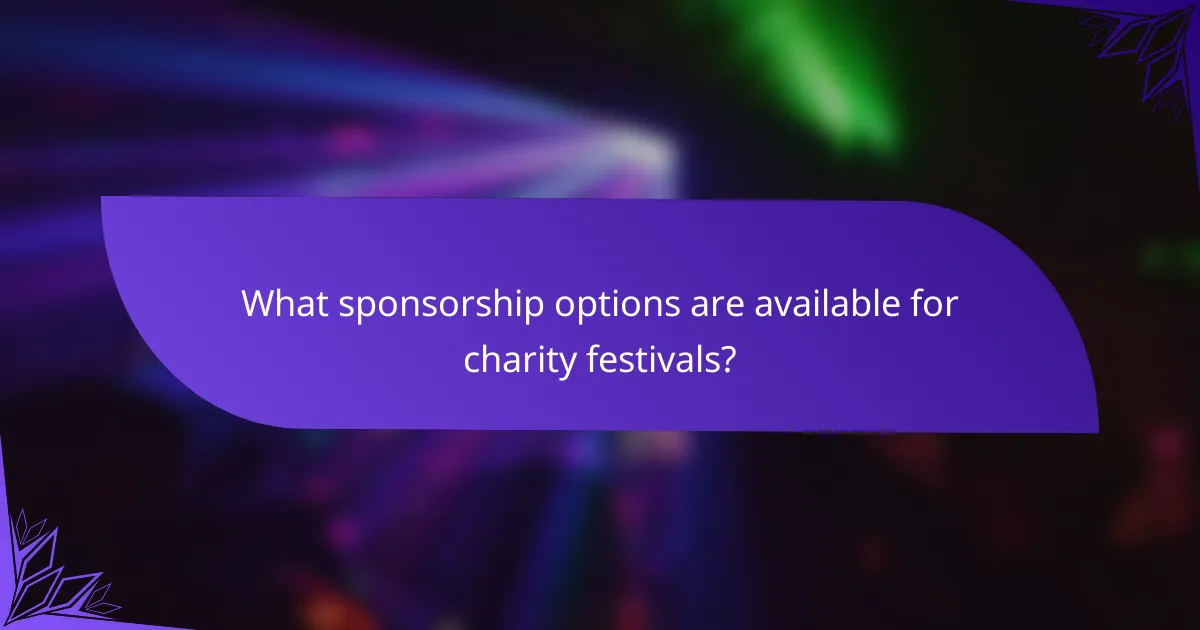
What sponsorship options are available for charity festivals?
Charity festivals offer various sponsorship options that cater to different types of businesses and organizations. These options typically range from local business packages to corporate sponsorships, allowing sponsors to choose a level of involvement that aligns with their goals and budget.
Local business sponsorship packages
Local businesses can participate in charity festivals through tailored sponsorship packages that often include advertising opportunities, vendor space, and promotional materials. These packages are designed to enhance community engagement while providing businesses with visibility among festival attendees.
Common options for local business sponsorships may include tiered packages, such as Bronze, Silver, and Gold levels, each offering varying degrees of exposure and benefits. For example, a Bronze package might include logo placement on event signage, while a Gold package could offer a booth at the festival and social media mentions.
Corporate sponsorship opportunities
Corporate sponsorships typically involve larger investments and can provide significant branding opportunities at charity festivals. Corporations can choose from various levels of sponsorship that may include exclusive naming rights, prominent logo placement, and opportunities for employee engagement through volunteering.
These opportunities can range from tens of thousands to hundreds of thousands of dollars, depending on the festival’s size and reach. Corporations should consider their marketing objectives and the target audience of the festival when selecting a sponsorship level to maximize their return on investment.
In-kind sponsorship benefits
In-kind sponsorships involve donating goods or services instead of cash, which can be highly beneficial for both the festival and the sponsor. Examples include providing food and beverages, equipment rentals, or entertainment services. This type of sponsorship can help reduce festival costs while offering sponsors exposure to attendees.
In-kind sponsors should ensure that their contributions align with the festival’s needs and audience preferences. Clear agreements outlining the value of the in-kind donations and the corresponding benefits, such as branding opportunities, should be established to ensure mutual benefit.
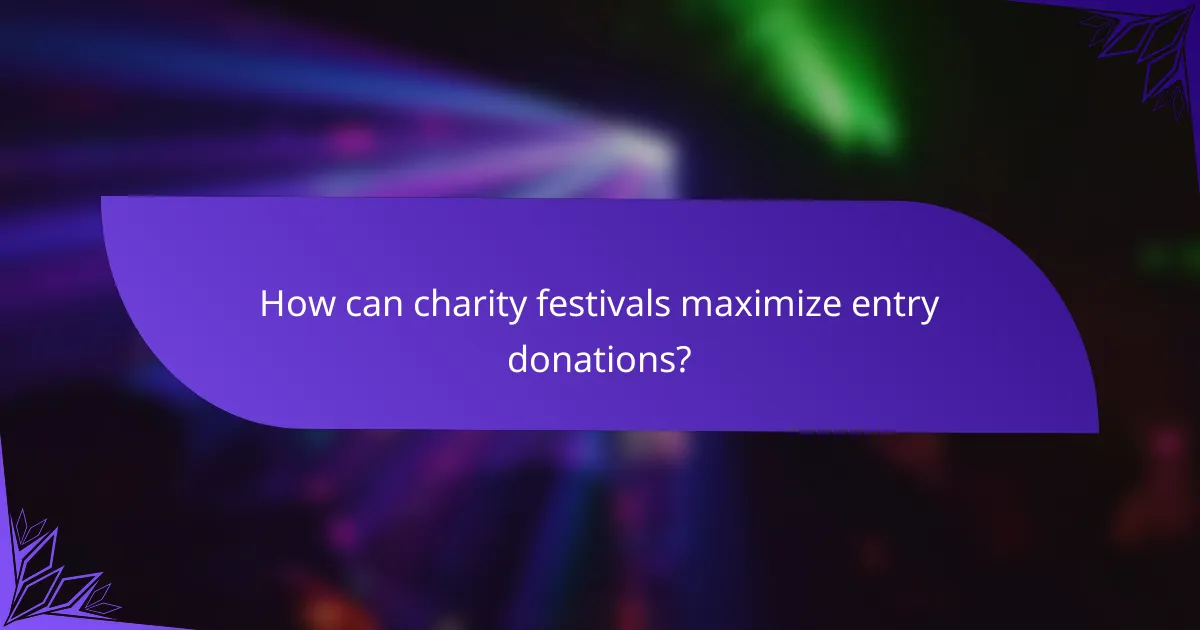
How can charity festivals maximize entry donations?
Charity festivals can significantly enhance entry donations by implementing strategic pricing, offering unique experiences, and promoting early ticket sales. These methods not only attract more attendees but also encourage higher contributions to the cause.
Tiered ticket pricing strategies
Implementing tiered ticket pricing allows festivals to cater to different donor capabilities and preferences. For example, offering standard, premium, and VIP tickets can appeal to a broader audience, with prices ranging from affordable to higher-end options.
Consider setting the standard ticket at a low price point, while premium tickets could include added benefits like reserved seating or complimentary refreshments. This strategy can increase overall donations as attendees choose higher-priced options for enhanced experiences.
Offering exclusive experiences for higher donations
Exclusive experiences can entice attendees to donate more. For instance, offering meet-and-greet opportunities with performers, behind-the-scenes tours, or special workshops can create a sense of value that justifies higher ticket prices.
These experiences should be limited in availability to enhance their appeal. For example, only a small number of VIP tickets could include a private dinner with festival organizers, encouraging attendees to opt for these higher donation levels.
Promoting early bird ticket sales
Early bird ticket sales can boost initial donations by incentivizing attendees to commit early. Offering a discount for tickets purchased well in advance can create urgency and encourage early financial support for the festival.
Promote these early sales through social media and email campaigns, highlighting the limited-time offer. This strategy not only secures funds ahead of the event but also helps gauge interest and plan accordingly for attendance and logistics.
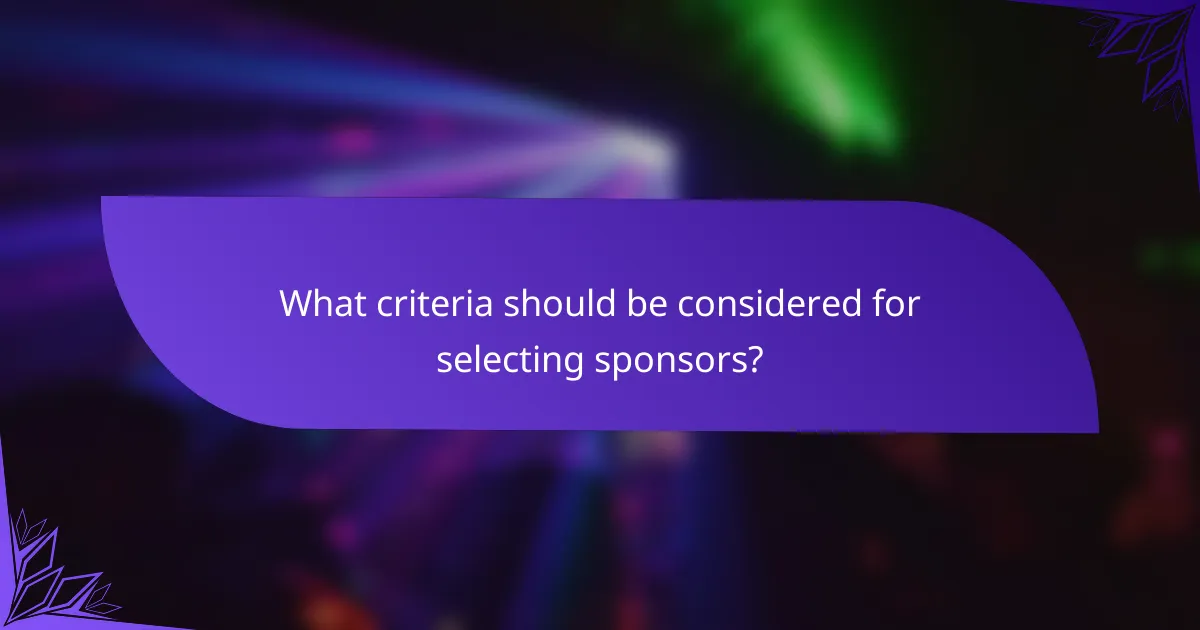
What criteria should be considered for selecting sponsors?
Selecting sponsors for a charity festival involves evaluating several key criteria to ensure a mutually beneficial partnership. Important factors include alignment with the festival’s values, compatibility with the target audience, and a track record of successful sponsorships.
Alignment with festival values
It’s crucial that potential sponsors share the core values of the charity festival. This alignment fosters authenticity and strengthens the festival’s brand. For example, a festival focused on environmental sustainability should consider sponsors that prioritize eco-friendly practices.
To assess alignment, review the sponsor’s mission statement, past initiatives, and community involvement. A strong match can enhance the festival’s credibility and attract attendees who resonate with both the festival and the sponsor.
Target audience compatibility
Understanding the demographics and interests of the festival’s audience is essential when selecting sponsors. Sponsors should appeal to the same audience segments to maximize engagement and impact. For instance, a family-oriented festival may benefit from sponsors in the children’s products sector.
Conduct market research to identify the audience’s preferences and behaviors. This information can guide you in choosing sponsors whose products or services will resonate with attendees, leading to a more successful partnership.
Previous sponsorship success stories
Reviewing past sponsorships can provide valuable insights into what works well for similar events. Successful sponsorships often lead to increased visibility and donations for both the festival and the sponsor. Look for case studies or testimonials from previous sponsors to gauge effectiveness.
Consider organizing a meeting with potential sponsors to discuss their past experiences and how they can replicate that success at your festival. This dialogue can reveal their commitment and strategies for contributing to your fundraising goals.

How can charity festivals leverage social media for fundraising?
Charity festivals can effectively use social media to enhance fundraising efforts by reaching a wider audience and engaging potential donors. By creating compelling content and utilizing interactive features, festivals can encourage donations and build community support.
Creating engaging content
Engaging content is crucial for attracting attention on social media. This can include eye-catching images, videos showcasing festival highlights, and stories of beneficiaries that resonate with your audience. Use a mix of formats, such as infographics and testimonials, to keep your content fresh and appealing.
Consider creating a content calendar to plan posts leading up to the event. This ensures consistent messaging and allows you to highlight different aspects of the festival, such as performers, sponsors, and donation impacts, keeping followers excited and informed.
Utilizing live streaming for events
Live streaming during charity festivals can significantly boost engagement and donations. By broadcasting key moments, such as performances or speeches, you can reach those who cannot attend in person. Platforms like Facebook Live or Instagram Live allow for real-time interaction, encouraging viewers to donate as they watch.
Promote your live stream in advance to build anticipation. Consider setting specific fundraising goals during the stream, such as matching donations for a limited time, to motivate viewers to contribute while they are engaged.
Running social media campaigns
Social media campaigns can amplify your fundraising efforts by creating buzz around the festival. Use targeted ads to reach specific demographics likely to support your cause, and consider using hashtags to unify your messaging across platforms. Campaigns can include challenges, contests, or matching donation drives to incentivize participation.
Track the performance of your campaigns through analytics tools to understand what resonates with your audience. Adjust your strategies based on engagement metrics, and be prepared to pivot your approach to maximize donations leading up to and during the festival.
